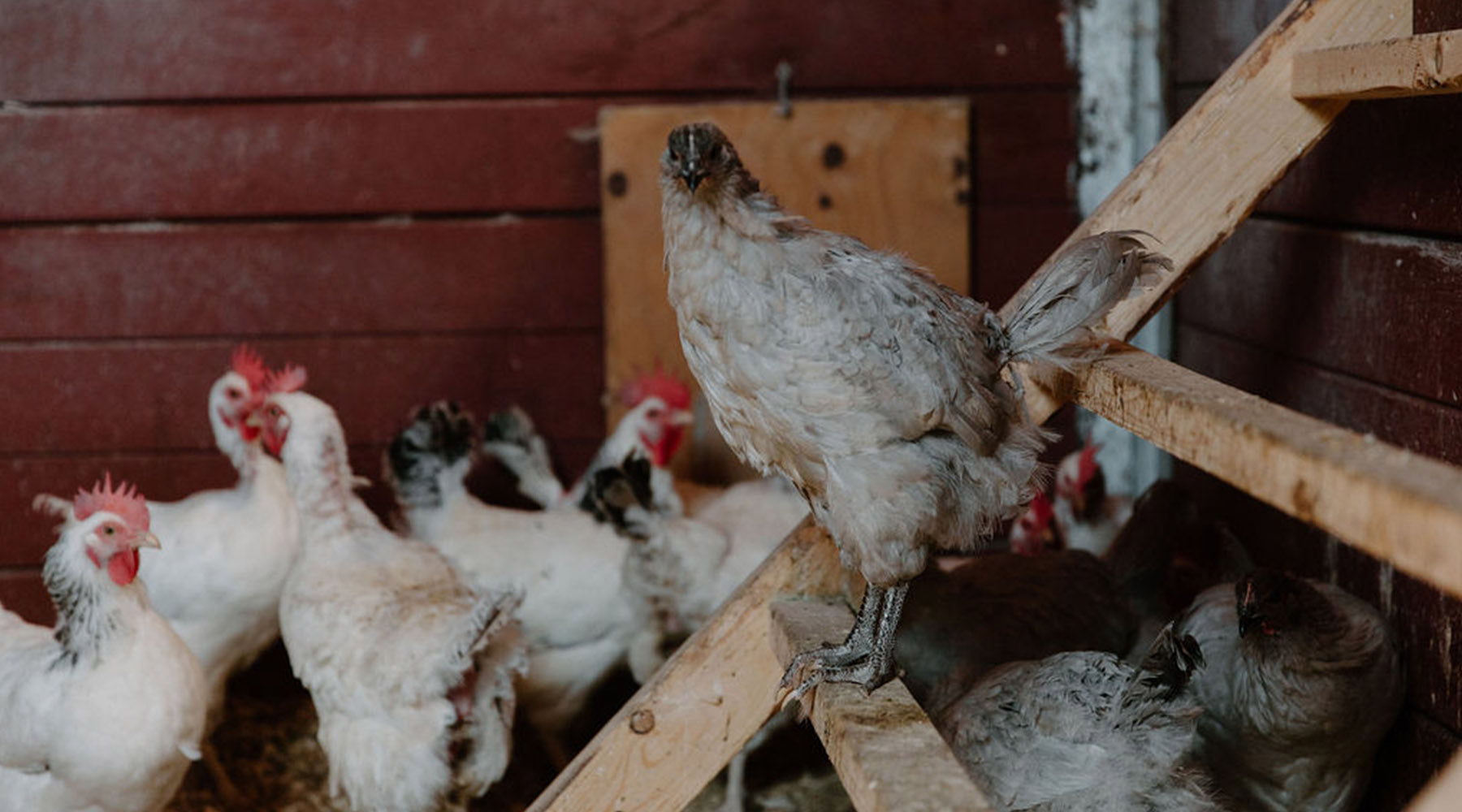The idea of keeping chickens in your own backyard is pretty appealing. Who doesn’t love the promise of fresh eggs, shortening the supply chain, and interacting with your very own farm animals? But, while the benefits are indisputable, raising a flock of hens isn’t for everyone. Here’s everything you should know about backyard chickens before you head out to your local hatchery.
1. Consider your lifestyle.
While chickens might be more emotionally independent than your average dog, they aren’t set-and-forget pets. So if you love travelling and value spontaneity and independence, they’re probably not the best choice for you.
Raising a few backyard hens may not be a full-time job, but they do need tending to on a pretty consistent schedule — and not just for the next year or two. Chickens can live anywhere from a few years to a decade, or even more. And, while they’re a long-term commitment, their egg production typically begins to taper off around three and eventually stops completely. If you’re set on maintaining a constant supply of eggs, you’ll likely have to continue adding to your flock over the years to maintain the same number of eggs.
Chickens may also carry salmonella bacteria in their digestive tract which can sicken people or pets they interact with — sometimes with deadly consequences. If you have a baby crawling around the yard, you may want to wait on having birds until your little one is toddling. However, while this is a consideration, it doesn’t have to be a deal breaker. Proper hand hygiene after handling the birds is typically enough to prevent infecting yourself.

2. Check your local municipal by-laws.
Not every community permits backyard birds. Even in places where they are allowed, there are often restrictions when it comes to roosters or the total number of birds you can own. Before you dive too deeply into the ins-and-outs of raising chickens, double check your local municipal by-laws and any homeowners association legislation you may be subject to. If your local by-laws don’t permit chicken keeping, you’re likely going to be out a lot of money and effort if you push ahead anyway.
3. Plan your space
They may not be much bigger than the average house cat, but chickens require more space than you may think. Inside the coop, each bird needs somewhere between three to five feet, and that’s before you factor in all the outdoor space they need to run around.
Moreover, as the birds live most happily in groups, keeping a minimum of three works best. To figure out the minimum amount of space you’ll need for your flock, you can check out any number of chicken coop size calculators online. Just remember that most of these provide the minimum space allowable and the more run space you provide your birds, the happier they’re likely to be.
While it may seem like a lot of space to dedicate, it’ll be worth it. Since young chickens lay roughly once a day, a flock of three will yield between one-and-a-half to two dozen eggs a week, which should be more than enough for most families.
4. Build a four-season coop.
Raising chickens in the spring and summer is all well and fine, but they can’t simply move in with you once the temperature starts to dip. As a result, you’ll need to make sure that their coop is properly winterized.
To this end, you’ll need to insulate the space if fall and winter temperatures drop to below 2°C where you live. But be warned, while you’ll want to seal any cracks or holes in the structure, you’ll need to strike a balance between shutting out the cold and maintaining adequate airflow.
Chicken poop is largely water, which means that your flock is capable of generating a surprising amount of moisture. Left long enough in a warm, fully sealed environment, this can provide the perfect medium for bacteria and mould. To prevent this, stay on top of regular coop cleanings and ensure proper coop ventilation with roof vents.
In addition, consider installing a thermometer inside your birdhouse and checking the temperature regularly to ensure your flock is warm enough. And despite the cold, don’t stop offering the option of outdoor time. While it’ll be more limited, the birds will still need an external space to roam that’s clear of any snow.
5. Get familiar with chicken feed.
Keeping a flock of chickens can be hugely rewarding, but not everything about it is intuitive. If your chickens are eating commercial food that’s specially formulated for their needs, you don’t have to worry much. However, if you’re letting them forage and feeding them grains or scraps, they will need a couple of other components to keep them healthy.
Since laying eggs requires calcium to ensure thick shells, your birds will need access to a reliable supplementary supply of it. Commercially available ground oyster shells, crushed eggshells, or black soldier fly grubs are all great options.
Also, since chickens don’t have teeth, they need help breaking up even soft foods — including grass. To this end, they routinely pick up tiny pieces of rock that they store in their gizzard. This is known as grit, and it helps to break down the food they ingest.
If your outdoor chicken run doesn’t provide natural sources of it, you must supplement your bird’s diet with store-bought grit or they risk intestinal blockages and even death. You’ll also need to regularly inspect their outdoor area and remove any garbage, wood chips, or long grasses, as these have the potential to cause intestinal obstructions.
6. Predator-proof your coop.
Living in an urban environment might give you the impression that your birds are safe. But even in the most metropolitan locations, chickens can fall prey to a number of different animals. Raccoons, hawks, weasels, snakes, owls, foxes, coyotes, and even skunks are just some of the potential killers lurking nearby.
To keep your backyard birds safe, consider getting an automatic predator door to keep out any nocturnal marauders. You can also program these doors to open and shut at certain times, allowing you to take the occasional night off or enjoy a morning sleep in.
In addition, you’ll want to add chicken wire on the roof of the outdoor run to prevent birds of prey from carrying off your flock. Burying a woven metal mesh called hardware cloth around the coop will prevent predators from digging underneath and finding a way in, while placing it around the run, and sealing cracks will keep out weasels and rats. You can also consider motion-activated lighting to scare off skunks; but know that that won’t deter most urban raccoons.
7. Furnish the coop properly.
Just like you wouldn’t enjoy living in an empty house, your chickens won’t thrive in an empty coop. While you won’t need to buy chicken-sized furniture, your birds will need a few non-negotiables to flourish in their new home.
It almost goes without saying, but every chicken coop must contain easily accessible food and water sources for the birds. However, these aren’t the only must-have items on the list.
To sleep comfortably, chickens use roosting perches. These do double duty by helping the birds feel safe, as well as keeping them off a cold floor. You can use a ladder, a few two-by-fours, or almost anything else you have lying around to make these, provided they’re sturdy, off the ground, and made out of wood.
Hens also need somewhere comfortable to lay their eggs. Nesting boxes provide this cozy and semi-private environment, while simplifying the egg search for you. Best of all, because the birds don’t spend large amounts of time in them, you won’t need a nesting box for each of your hens. Instead, you’re looking at a ratio of about one box for every three birds. These can also make a nice do-it-yourself project to save on costs.

8. Don’t forget to budget.
The start-up costs for chickens can be considerable. Once you factor in the coop, bedding, nesting boxes, lighting, heating, feed, any supplements, and the birds themselves, you’re looking at anywhere from several hundred to several thousand dollars. And that’s before factoring in any veterinary care they might need.
While you may eventually recoup your costs by selling eggs or through savings on your grocery bills, that won’t be the case at first. In fact, depending on your feed bill and how many birds you have off-lay, it may actually be more economical to buy your eggs at the supermarket. It’s best to crunch the numbers and make sure you have the capital before you go too far down the backyard chicken rabbit hole.
9. Keep learning.
Chicken diets and behaviours aren’t always straightforward. For example, while chickens are omnivores, they have some major dietary don’ts like avocados, which can be toxic to the birds. While it’s generally safe and healthy to feed your chickens a variety of kitchen scraps, take some time to research and get familiar with which foods are okay and which ones you should avoid.
Food isn’t the only area of study. Chickens are fascinating, complex creatures that make more than 30 different sounds, and learning what they’re clucking about can help you understand your flock better. Beyond online resources and veterinary manuals, local farmers or chicken rearing groups on social media may provide good sources of information.
10. Have fun!
Chickens are a lot of work, but as social animals, most are happy to bond with their human flock members and they can make great companions. In fact, chickens recognize people and many will let you pet them — if you approach them slowly and build a rapport over time. While fresh eggs might be the reason you go into backyard chicken farming, you’re guaranteed to come out with a new flock of friends and have a great time doing it.

